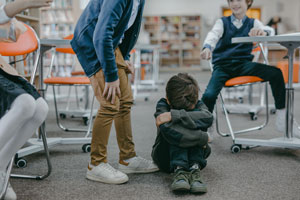
About 20 percent of U.S. students say they have experienced bullying. That’s one in five kids.
SafeUT, a free chat and tip line that provides real-time crisis intervention for students, parents/guardians, and educators, received 994 tips regarding bullying between July 1, 2021, and June 30, 2022, accounting for 12 percent of total tips submitted. During that time, bullying was the second-most reported tip. These statistics only factor in those who came forward with their experience. Experts say there are likely more instances of bullying, but children are often too nervous or ashamed to speak up about it. That’s where adults can—and should—help.
October is National Bullying Prevention Month and, in order to prevent bullying, we all need to know the signs of bullying, how to safely stop it, and what resources are available to help.
How bullying impacts young children
Bullying is an “incredibly common and destructive process that happens throughout the lifespan,” says Scott Langenecker, MD, a clinical neuropsychologist at the Huntsman Mental Health Institute, “but it hurts the most when you’re young.”
While all children can experience bullying at some point, psychologists say certain children are more susceptible to bullying, including neurodivergent, LGBTQIA+, and children from underserved communities. José Rodríguez, MD, associate vice president for health equity, diversity, and inclusion at University of Utah Health, says he knows first-hand how racism can also play a role in bullying.
“Bullying is a terrible problem,” Rodríguez says. “Having experienced it both as an adult and a child, I understand how bullying can cause significant obstacles.”
Those obstacles can include isolation, feelings of inferiority, and a host of mental health problems, Rodríguez says.
Being bullied at a young age can affect someone well past childhood and have lifelong psychological impact. Children can quickly internalize bullying, which can lead to depression and anxiety. In some cases, bullying can lead a child to suicide. Anne V. Kirby, PhD, an Adjunct Assistant Professor in the Department of Psychiatry whose research centers around individuals on the autism spectrum or with other disabilities, says that Utah students with autism who are bullied are 1.5 times more likely to die by suicide than non-autistic students.
Understanding the signs can help with early intervention, which is crucial to mitigating the mental health impacts of bullying.
Signs a child is being bullied
Bullying can lead to a few different changes in a child’s behavior, Langenecker says. Some signs of bullying are obvious, like unexplained injuries. Others are more subtle, like difficulty falling asleep. Kids can also give vague reasons for not wanting to participate in activities they typically enjoy.
StopBullying.gov lists a few more signs, including:
- Lost or destroyed clothing, books, electronics, or jewelry.
- Frequent headaches or stomach aches, feeling sick, or faking illness.
- Changes in eating habits, like suddenly skipping meals or binge eating. Kids may come home from school hungry because they did not eat lunch.
- Declining grades, loss of interest in schoolwork, or not wanting to go to school.
- Self-destructive behaviors such as running away from home, harming themselves, or talking about suicide.
Signs a child is bullying others
There are also some telltale signs your child might be bullying others, according to StopBullying.gov, including:
- Getting into physical or verbal fights.
- Having friends who bully others.
- Becoming increasingly aggressive.
- Getting sent to the principal’s office or to detention frequently.
- Acquiring unexplained extra money or new belongings.
- Blaming others for their problems.
- Not accepting responsibility for their actions.
How you can help stop and prevent bullying
Adults play a critical role in stopping and preventing bullying. Kids might not always be open about being bullied because of complex emotions, like fear and shame.
“We have to pay attention,” Langenecker says. “A lot of children suffer in silence.”
Start by asking your children if there’s anything they’d like to speak with you about. Create as much space for open conversation as possible so that the child feels they can speak openly about bullying they’ve seen or experienced.
It’s equally important to teach children compassion from an early age to break complex cycles of bullying.
“It’s important to realize that people who engage in bullying are often victims of bullying themselves,” Langenecker says. “For parents, administrators, educators, it’s important to teach skills around compassion, caring for other people, respecting one another, and creating a culture in which bullying is reported and treated seriously.”
If your child is bullying, experts say adults don’t need to feel shame—but they should work to correct the behavior and create room for growth.
“Fear is a major motivation in bullying,” Rodríguez says. “Helping people to feel safe in their own skin is going to help mitigate the amount of bullying going on. The antidote for bullying is love. How do we help perpetrators feel the love they need so they don’t hurt others?”
Discipline is always better than punishment, Rodríguez says. Push for acknowledgment and accountability. Ask them to apologize to whomever they bullied and talk about what needs to be done to ensure it doesn’t happen again.
When in doubt, reach out. Students, parents, and educators can reach out through the SafeUT app to chat real-time with a crisis counselor at Huntsman Mental Health Institute or submit a tip regarding an instance of bullying. In an effort to increase awareness of how the app can support bullying prevention, this academic year, SafeUT launched a digital ad campaign and partnered with schools to promote anti-bullying messaging. Huntsman Mental Health Institute also has a wide variety of programs to treat children and teens. Help is available, reach out today to learn more.